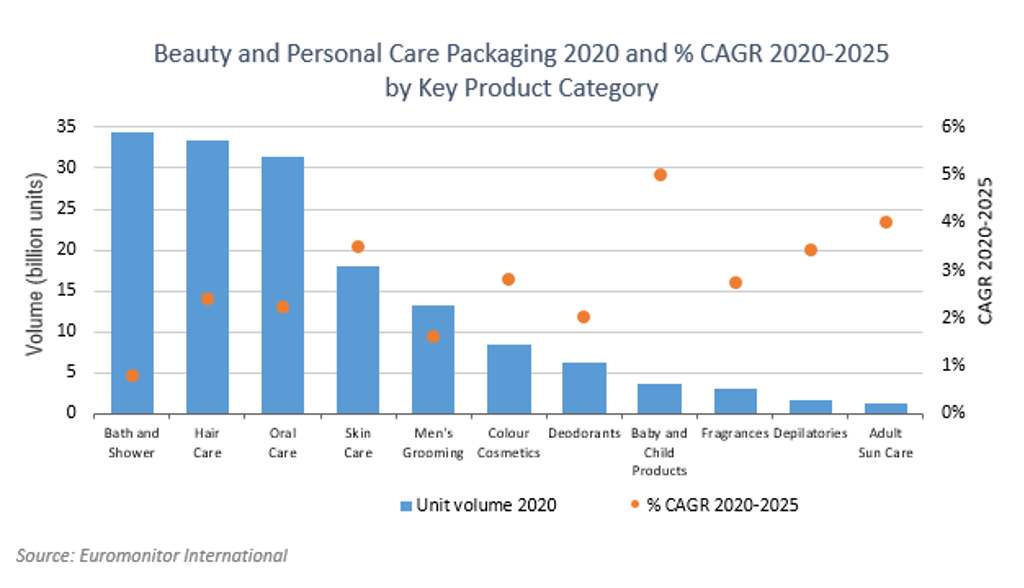The beauty packaging industry is resilient. Despite the pandemic, sales increased by 3% from 2020 to 2021. Toiletries categories remain the largest contributors to packaging volumes globally, led by everyday hygiene products such as bar soap, shampoo and toothpaste. To meet the needs of new consumer routines, shopping habits and preferences, beauty brands are changing their packaging designs in fundamental ways and prioritising sustainable and digital investments.

The pandemic heightened the focus on health, wellbeing and hygiene. While product claims such as holistic, clean, and natural still resonate with consumers, their focus is shifting towards the basic principles of health and being free from disease. Beauty consumers are embracing self-care and adopting healthier lifestyles, with the home becoming their main wellness hub. In terms of packaging, the focus on hygiene translates into growing packaging volumes for toiletries, and demand for hygienic solutions continues to grow, benefiting stick formats in categories such as skin care and colour cosmetics. For example, Milk Makeup’s range of products in stick format allows consumers to carry out a skin care routine without touching their face. Meanwhile, ingredient safety and transparency have also become essential to consumers. Increasingly, therefore, brands clearly list the ingredients used in the composition of their products on the packaging, protect the integrity of the formulation using airless packaging, and use NFT technology to convey more information on the product.
Sustainable packaging is a key factor driving purchases
According to Euromonitor International’s Voice of the Consumer: Lifestyles Survey, 67% of consumers tried to have a positive impact on the environment through their everyday actions in 2021. Similarly, 46% of global consumers used sustainable packaging such as refillable, recyclable, biodegradable or compostable packaging in 2021. The beauty industry has been focusing on sustainability for a long time, but the pandemic put social and environmental issues in the spotlight, leading consumers to opt for brands that can deliver positive change. Increasingly, companies are under scrutiny to honour any commitments made to build a more sustainable and ethical future. Also, brand owners and packaging manufacturers are accelerating eco-friendly innovations to reduce plastic use and water waste. For instance, The Body Shop relaunched its body butter range in recyclable packaging made of a 100% recycled PET jar and aluminium lid. Meanwhile, Unilever, following the launch of its refillable Dove deodorant in 2021, extended its refillable offer by launching a concentrated refill for its Dove Body Wash in 2022.
E-commerce continues to gain ground
The beauty industry still heavily relies on store-based sales. However, e-commerce gained momentum during the pandemic, with beauty shoppers moving online. In 2021, 18% of global beauty value sales were made online, posting an increase of six percentage points in comparison to pre pandemic, in 2019. Online shopping is predicted to grow faster in the years to come. Euromonitor’s Voice of the Industry 2021 survey also shows that beauty companies consider that changes in consumers’ shopping and spending behaviour as a result of the pandemic will be permanent. Rising demand for beauty products online requires robust packaging fit for shipping. Growing volumes of letter box packaging are being seen as the penetration of beauty subscriptions continues to rise, with brands such as Curology offering bespoke skin care products delivered through the letter box. Besides, the shift towards e-commerce has prompted new beauty sampling solutions, especially in fragrances and colour cosmetics. Christian Dior launched its J’adore fragrance in a miniature roller-pearl format which comes in a 20ml pack size. This smaller pack size can be an alternative to sampling and represents an entry point to the premium beauty universe.
Evolving wellness priorities require beauty companies to adjust their product and packaging offer to meet consumers’ new needs, while ensuring trust, safety and transparency. And, as technology develops, innovation is expected to focus on circular models, as well as sustainable and transparent supply chains. Meanwhile, digitalisation and the rise of e-commerce will impact the evolution of the role of packaging and its design requirements, and establishing a strong digital presence will set beauty companies apart from competitors.
For further insight, read the full report Beauty and Personal Care Packaging: Key Trends and Innovations.
